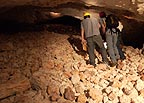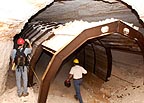August 23, 2005
SIUC zoologist leads effort to save endangered bats
CARBONDALE, Ill. -- A group of burly guys will rev up heavy machinery later this week at an old Southern Illinois mine in hopes of saving endangered Indiana bats.Timothy C. "Tim" Carter, a Southern Illinois University Carbondale zoologist, is in charge of the project. Several big federal, state and corporate partners are helping as well.
Together, they'll reinforce the collapsing entrance to Jason Mine, a defunct Alexander County room and pillar mine that until the early 1990's produced microcrystalline silica. Unimin Specialty Minerals Inc. owns the mine, located near Elco, and still extracts the powdery, white mineral — used in house paint, pool cue chalk and lens polish — from newer, nearby strip mines.
After the Jason Mine closed, Indiana bats moved in.
Media Advisory
Reporters, photographers and film crews may cover the construction phase on Wednesday and Thursday, Aug. 24 and 25. Call ahead of time to arrange a site visit. Carter is at 618/559-4586. He'll meet you between 8:30 and 9 a.m. either morning outside Unimin's office near Elco. And he'll provide detailed driving directions to the meeting place. The surrounding terrain is rugged and surrounded by forest so you'll want to dress accordingly.
During the day, they cluster by the thousands, clinging upside down from ceilings that meet their preferred temperature and humidity ranges deep inside the mine.
Securing Jason's entrance will ensure the bats' long-term access. And it's also expected to improve airflow and moderate humidity, creating optimum conditions to draw even more bats to the mine's meandering tunnels and 40 rooms.
The team has every reason to expect superlative results.
A prototype project at Unimin's nearby Magazine Mine tells the tale: The population of the bat colony there skyrocketed after the entrance was reinforced with 10 steel arches, measuring 15 feet across and 10-feet tall and weighing 800 pounds apiece.
A recent winter survey of Magazine counted 50,000 hibernating bats— a mammoth jump from the mere 100 bats found there in 1996.
"We think in the future, Jason could become another Magazine," says Carter. "Right now, Jason is the only one of 50 mines out here whose bat populations are decreasing. It's priority one. It's exceptionally important."
Unimin's onboard. So are the U.S. Forest Service, the Illinois Department of Natural Resources, U.S. Fish and Wildlife Service, Little Egypt Welding Co. and SIUC.
They're pooling resources to temporarily clear a path through the forest to get heavy equipment in. Then, they'll clear rubble from Jason's entrance and install arches to prevent its roof and walls from collapsing and closing in.
Finally, a grated steel gate — with ample openings big enough for bats in flight — will be welded into place. That will prevent predators, both human and otherwise. And it will keep out uninvited explorers.
As human developments encroach on bat habitats, mines like these have become welcome havens for dwindling Indiana bats.
In 1960, experts counted 880,000 Indiana bats in their native Central and Eastern U.S. territories. Today, there are fewer than half as many. The nosedive baffles wildlife experts.
The trend makes restoration projects like this especially valuable to the species, Carter says.
"About 80 percent of Indiana bats hibernate in just nine locations around the Midwest. We've got 36,000 of them using similar abandoned mines nearby. That means we have a tenth of the population here in Illinois."
Once Jason is reclaimed, "we hope more bats will relocate to our area and hopefully they'll have better survival rates," says Carter.
Leading in research, scholarly and creative activities is among the goals of Southern at 150: Building Excellence Through Commitment, the blueprint for the University's development by the time it reaches its 150th anniversary in 2019.
(EDITORS: A sidebar, "Myths and facts about bats," accompanies this story.)
Photo 1: Closeup of bat,wings.jpg
Arghhh — An endangered Indiana bat strikes a fierce pose when handled by zoologist Timothy C. “Tim” Carter, a Southern Illinois University Carbondale scientist who’s heading up a collaborative project to shore up a Unimin Specialty Minerals Inc. mine near Elco, Ill., for hibernating bats.
Photo 2: bat entrance.jpg
Bat cave — Steel arches and heavy timbers stabilize the entrance to Unimin Specialty Minerals’.Magazine Mine, a defunct silica mine that is now a safe haven for up to 50,000 bats in five species. Southern Illinois University Carbondale bat expert Timothy C. Carter, a zoologist, is heading up a collaborate project to restore a similar mine in hopes of bettering its internal conditions to attract and shelter even more bats, whose numbers continue to decline.
Photo 3: batman.jpg
Batman — Timothy C. “Tim” Carter, Southern Illinois University Carbondale’s resident bat expert, inside an old Unimin Specialty Minerals’ silica mine near Elco, Ill., that is now a thriving bat hibernaculum.
Carter and numerous government and corporate partners are restoring a second nearby mine in hopes it will become as popular a winter hangout as this location.
Photo 4: bats.jpg
Bachelor pad — An estimated 4,000 male bats cluster upside down from the roof of a closed Unimin Minerals Specialty Inc. silica mine near Elco, Ill. Southern Illinois University Carbondale zoologist Timothy C. “Tim” Carter is leading a team of governmental and corporate partners who’re restorin a similar, defunct mine to improve conditions for endangered Indiana bats.
In summer, females and their young leave the hibernacula for the forests. Contented males stick around and form bachelor colonies like these.
Photo 5: bat tunnel inside.jpg
Safe and sound — Steel arches and wood supports like those seen here are being installed to prevent roof and wall collapses at the entrance of Jason Mine, a Unimin Specialty Minerals mine near Elco, Ill. Securing the entrance, says Southern Illinois University Carbondale zoologist Timothy C. “Tim” Carter, will improve airflow to make the site a more suitable winter hibernation spot for endangered Indiana bats.All Photos by Russell Bailey
Media & Communication Resources






